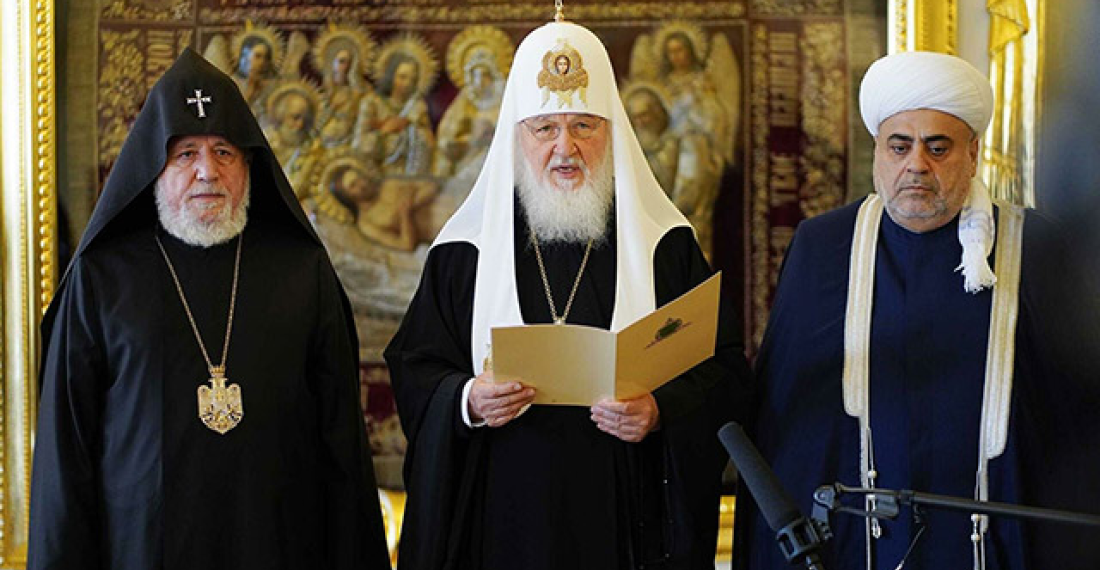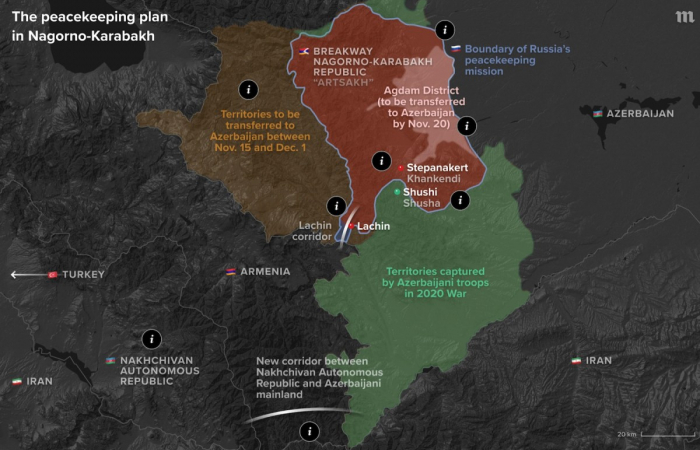"Religion has taken a place in the narratives that depict two warring sides locked into perpetual battle, and the international media nearly always frames the conflict as one between “Christian Armenia” and “Muslim Azerbaijan”, implanting that image in the minds of readers," writes Onnik James Krikorian in this op-ed for commonspace.eu. "Thus, at some point, the question of religious diplomacy to dispel such inaccuracies should also be factored into future Track II diplomacy efforts," he adds.
On 15 October 2020, as war waged between Armenia and Azerbaijan over Nagorno-Karabakh, a baptist cleric convened a multi-confessional joint service for peace in Tbilisi. Despite the tensions and hostilities, Bishop Malkhaz Songulashvili invited Armenian and Azerbaijani clergy to come together.
The service was held at the “Peace Cathedral” in the Georgian capital, a repurposed space to, as Songulashvili says, respond to “ugliness with beauty.” It seeks to encourage interfaith dialogue between the three Abrahamic faiths – Christianity, Islam, and Judaism.
Ethnic Armenians and Azerbaijanis make up the two largest ethnic minorities in the country – numbering around 168,000 and 233,000 according to the 2014 Georgian census. In total, that is around 10.8% of the population, leaving some concerned that the 2020 Karabakh war could influence inter-ethnic relations.
"It took some effort to convince the Azerbaijani and Armenian clergy that we should come together and pray immediately," Songulashvili told media at the time, "but as we came together, talked to each other and prayed together for peace, the tensions evaporated.”
The service was attended by Pastor Narek Kushyan of the Armenian Apostolic Church, Sheik Mirtagi Asadov of the Supreme Council of Azerbaijani Muslims in Georgia, and from the country’s Yezidi minority, Aktiar Air Dimitry Pirbari. Each prayed in their own language and quoted scripture from the Bible and Koran.
"Georgia is a multicultural country and we live here together"
"We, the Yezidi, Muslim and Christian clergy gathered in the Peace Cathedral, commit ourselves to hold a weekly vigil together for peace and reconciliation between Armenia and Azerbaijan until the war is over,” a joint statement read. Another joint service was held on 24 October.
The National reported that the ethnic Armenian and Azerbaijanis in attendance did not want to leave the cathedral. “Georgia is a multicultural country and we live here together,” Rima Marangozyan, a student, told the paper. “We tried to look at both sides of the war because we know it's not the people who are guilty.”
“Ethnic hostility between Armenians and Azeris is artificial,” Said Babazade, an Azerbaijani journalist who had relatives killed in the conflict, added. “We have more in common with Armenians than Georgians.”
Many Armenian and Azerbaijanis in the two republics neighbouring Georgia might disagree with that comment, but though some nationalists have used religion to exaggerate the differences between the two peoples, many analysts agree that the conflict over Karabakh has never really taken on a religious dimension.
It is an ethnic or political conflict, they maintain.
Religious diplomacy to dispel inaccuracies should be factored into future Track II efforts
Nonetheless, religion has taken a place in the narratives that depict two warring sides locked into perpetual battle, and the international media nearly always frames the conflict as one between “Christian Armenia” and “Muslim Azerbaijan”, implanting that image in the minds of readers.
Thus, at some point, the question of religious diplomacy to dispel such inaccuracies should also be factored into future Track II diplomacy efforts. Indeed, prior to the 2020 interfaith prayers, the Catholicos of All Armenians, Garegin II, and Azerbaijan’s Sheikh-ul-Islam Allahshukur Pashazade had already been engaged.
In April 2010, a delegation led by the Armenian Catholicos visited Baku and met with Azerbaijani President Ilham Aliyev. They also prayed and sang hymns in the abandoned Armenian church in central Baku, the Azerbaijani capital. Etchmiadzin, the heart of the Armenian Apostolic Church, issued a statement afterwards.
The one hour meeting between Garegin II and Aliyev took place in “an unconstrained and sincere atmosphere.” Further, it read, “a great deal of importance was attached to mutual visits and contacts among the two peoples which will further bolster mutual trust and a spirit of cooperation.”
The landmark visit was organised by Russian Patriarch Kirill II and, the following year, Azerbaijan’s Pashazade visited Yerevan for a trilateral conference with the Russian and Armenian church leaders. In a joint statement, they called for the bilateral withdrawal of snipers from the Armenia-Azerbaijan line-of-contact.
That, of course, never happened and the violence has continued until the present day. Indeed, with both leaders possessing little influence in their home countries, the situation has also been made worse by the Armenian Catholicos’ clear opposition to Armenian Prime Minister Nikol Pashinyan.
The two have been in conflict since the 2018 “Velvet Revolution” that brought Pashinyan to power and has only increased following Armenia’s defeat in the 2020 war. Indeed, only last month Garegin II announced that his earlier call for the Armenian Prime Minister’s resignation was “indefinite.”
Religion is a factor that risks becoming more of an issue over time
But this does at least demonstrate how religion is becoming a factor that, while not directly responsible for the conflict thirty years ago, does risk becoming more of an issue over time. The 2020 multi-faith prayer for peace in Tbilisi, however, highlights that some activities are possible, even if only on neutral ground.
At some point too, the fate of Armenian and Azerbaijani cultural and religious monuments in each other’s countries will become even more pressing. Some work on this could already start now.
In September 2011, for example, the Austrian Foreign Ministry, the Organisation for Security and Cooperation in Europe (OSCE), and the Council of Europe, held an event in Vienna, in which I also participated, on "The Role and Responsibility of Religious Communities and Civil Society for Conflict Resolution in the South Caucasus.”
The meeting was attended by representatives from the religious communities themselves and media from Armenia, Azerbaijan, and Georgia. More than a decade later, however, the West now appears inactive in this area, though others aren’t. On 31 October 2021, Moscow organised another meeting between the Armenian, Azerbaijani, and Russian religious leaders and could well do so again.






